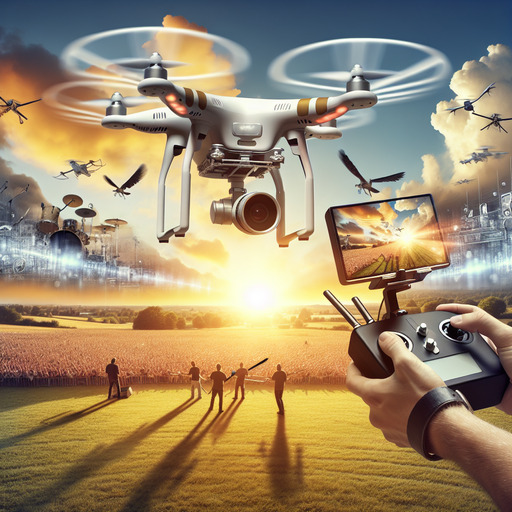
-
Table of Contents
Unlock the future of music video production with cutting-edge drone techniques! Elevate your visuals and captivate your audience. Learn more here.
Introduction
Music Video Production with Drones: Key Techniques
The advent of drone technology has revolutionized the landscape of music video production, offering filmmakers unprecedented creative possibilities and dynamic visual storytelling tools. Drones provide the ability to capture sweeping aerial shots, intricate movements, and unique perspectives that were once difficult or impossible to achieve with traditional filming methods. This introduction delves into the key techniques essential for leveraging drones in music video production, including pre-production planning, shot composition, camera settings, and post-production integration. By mastering these techniques, filmmakers can enhance the visual impact of their music videos, creating captivating and memorable experiences for audiences.
Mastering Music Video Production with Drones: Key Techniques for Cinematic Excellence
In the ever-evolving landscape of music video production, drones have emerged as a game-changing tool, offering filmmakers unprecedented creative possibilities. Mastering music video production with drones requires a blend of technical expertise, artistic vision, and meticulous planning. By understanding key techniques, filmmakers can harness the full potential of drones to achieve cinematic excellence.
To begin with, selecting the right drone is crucial. The market offers a wide range of drones, each with varying capabilities. High-end drones equipped with 4K cameras and advanced stabilization systems are ideal for capturing smooth, high-resolution footage. Additionally, drones with obstacle avoidance technology can navigate complex environments, ensuring safety and reducing the risk of accidents. Once the appropriate drone is chosen, it is essential to familiarize oneself with its controls and features through practice flights.
Pre-production planning is another critical aspect of successful drone-based music video production. This phase involves scouting locations, obtaining necessary permits, and developing a shot list. Location scouting helps identify visually appealing settings that complement the music and narrative. Securing permits ensures compliance with local regulations, which is particularly important when filming in urban areas or near restricted zones. A well-thought-out shot list, detailing the desired angles and movements, serves as a blueprint for the shoot, streamlining the production process.
When it comes to capturing footage, understanding and utilizing various drone maneuvers can significantly enhance the visual impact of a music video. Techniques such as the reveal shot, where the drone ascends to unveil a landscape or subject, create a sense of anticipation and grandeur. Similarly, the tracking shot, which involves following a moving subject, adds dynamism and energy to the video. Combining these maneuvers with smooth, controlled movements can result in captivating sequences that elevate the overall production quality.
Lighting plays a pivotal role in drone cinematography. Natural light, particularly during the golden hours of sunrise and sunset, can imbue scenes with a warm, ethereal quality. However, it is essential to be mindful of changing light conditions and plan accordingly. In some cases, artificial lighting may be necessary to achieve the desired effect. Utilizing portable LED lights or coordinating with ground-based lighting setups can help maintain consistent illumination and enhance the visual appeal of the footage.
Post-production is where the raw footage is transformed into a polished music video. Editing software such as Adobe Premiere Pro or Final Cut Pro offers a range of tools for color grading, stabilizing footage, and adding special effects. Color grading can enhance the mood and tone of the video, while stabilization tools can smooth out any residual shakiness. Additionally, incorporating visual effects, such as lens flares or motion graphics, can add a layer of sophistication and creativity.
Sound design is another crucial element that should not be overlooked. While the primary focus is on the music track, ambient sounds captured by the drone can add depth and realism to the video. Integrating these sounds subtly can create a more immersive experience for the viewer.
In conclusion, mastering music video production with drones involves a combination of technical proficiency, creative planning, and attention to detail. By selecting the right equipment, meticulously planning the shoot, employing effective drone maneuvers, and refining the footage in post-production, filmmakers can achieve cinematic excellence. As drone technology continues to advance, the possibilities for innovative and visually stunning music videos are boundless, offering filmmakers an exciting avenue to explore and express their artistic vision.
Q&A
1. **What are some key techniques for using drones in music video production?**
– **Pre-Production Planning:** Scout locations and plan shots in advance to ensure smooth execution.
– **Storyboarding:** Create detailed storyboards to visualize drone shots and their integration into the video.
– **Camera Settings:** Adjust camera settings for optimal exposure, focus, and frame rate to match the desired aesthetic.
– **Flight Path Coordination:** Plan and practice flight paths to capture dynamic and stable footage.
– **Safety Protocols:** Follow safety guidelines and regulations to ensure safe operation of the drone.
– **Post-Production:** Use stabilization software and color grading to enhance the final footage.
– **Creative Angles:** Experiment with unique angles and movements to add visual interest and complement the music.